Tag: history
Jonna Pulkkinen: Kieltolaki. Kielletyn viinan historia Suomessa. [Prohibition. A history of prohibited liquor in Finland.]
29 June 2015 | Mini reviews, Reviews
 Jonna Pulkkinen
Jonna Pulkkinen
Kieltolaki. Kielletyn viinan historia Suomessa. [Prohibition. A history of prohibited liquor in Finland.]
Helsinki: Minerva, 2015. 213pp., ill.
ISBN 978-952-312-112-6
€32,90, hardback
Prohibition of the making and selling of strong liquor was in force in Finland between 1919 and 1932. In this approachable book, the journalist and non-fiction writer Jonna Pulkkinen charts Finnish attitudes to alcohol over the ages and describes the origin and effects of prohibition. Total abstinence was popular in Finland in the second half of the 19th century, and was adopted in particular by the working class. Limits on alcoholic consumption were first imposed as early as the First World War. When a prohibition law that had been passed a couple of years earlier came into effect in newly independent Finland in 1919, however, support had already begun to dwindle. Home stills proliferated, smuggling from abroad was considerable and broadly accepted, and enforcing the law was difficult. Pulkkinen has numerous interesting and even comical examples that flouted the law on prohibition. The law was broken in all social classes, the use of liquor and crime increased throughout the country, and taxation income on alcohol was lost. As public criticism grew, an advisory referendum was held in 1931, and as a result the prohibition law was abolished the following year.
Kai Häggman: Pieni kansa, pitkä muisti. Suomalaisen Kirjallisuuden Seura talvisodasta 2000-luvulle. [Small nation, long memory. The Finnish Literature Society from the Winter War to the 21st century.]
16 June 2015 | Mini reviews, Reviews
 Kai Häggman
Kai Häggman
Pieni kansa, pitkä muisti. Suomalaisen Kirjallisuuden Seura talvisodasta 2000-luvulle. [Small nation, long memory. The Finnish Literature Society from the Winter War to the 21st century.]
Helsinki: SKS, 2015. 524pp., ill.
€48, hardback
The Finnish Literature Society, publisher of Books from Finland, is of unique importance as a collector of Finnish folk poetry and folk tradition, a publisher of literature and a promoter of research into the Finnish language and history; today it is known particularly as one of the most important publishers of the humanities. The historian Kai Häggman has published many works about publishing, and his new book, the third volume of a history of the Finnish Literature Society, describes events from the Second World War to the present day. Among other things, the book describes the Finnish Literature Society’s activities in conquered Eastern Karelia in what was then considered part of the Greater Finland, and its ideological development from narrow nationalism to the broader outlook of the post-war decades. In the late 20th century the generation that had lived through the war was replaced by younger people, and the study of the folk tradition embraced aspects of modern society; methods, too, were renewed. The book also casts light on relationships between Finnish scholars and those from kindred nations such as Estonia. Häggman gives a lively all-round view of the work of the Society as part of Finnish cultural history as a whole, emphasising the importance of the most important scholars, and not forgetting the occasional infighting.
Antero Holmila & Simo Mikkonen: Suomi sodan jälkeen. Pelon, katkeruuden ja toivon vuodet 1944-1949. [Finland after the war, 1944-1949. Years of fear, bitterness and hope.]
16 June 2015 | Mini reviews, Reviews
 Antero Holmila – Simo Mikkonen
Antero Holmila – Simo Mikkonen
Suomi sodan jälkeen. Pelon, katkeruuden ja toivon vuodet 1944-1949. [Finland after the war, 1944-1949. Years of fear, bitterness and hope.]
Helsinki: Atena, 2015. 2650., ill.
ISBN 978-952-300-112-1
€34, hardback
Finland lost the Winter War and the Continuation War that followed, to the Soviet Union, and was then forced to engage in the short Lapland War to expel its former allies, the Germans. The return to peace was not easy, as the historians Antero Holmila and Simo Mikkonen demonstrate in this highly readable book. Loss of territory meant finding homes for more than 400,000 evacuees elsewhere in Finland, and this was not achieved without difficulty. Soldiers were demobilised and had to redomicile themselves in ordinary life and work; there was a shortage of housing; and heavy war reparations were to be paid to the Soviet Union. Leading politicians accused of appeasing the Soviet Union during the war received prison sentences, which many people considered wrong. The work highlights the aspirations of the Communists and the internal fighting on the political left. The Communist party, which had been banned, returned to the political stage and was successful in the 1945 elections. The majority of the nation was fearful of the growth of influence of the Communists and, through them, the Soviet Union. However, the Social Democrats, competing with the Communists for workers’ votes, succeeded in gaining considerably more votes than the Communists as early as 1948. Although strikes and conflicts occurred, conditions settled down gradually towards the end of the 1940s and the nation began to get back on its feet.
Oldest Helsinki photograph
2 June 2015 | This 'n' that

Old Helsinki: this image, taken in the Esplanadi park more than 150 years ago, shows the old theatre building, which was demolished in the 1850s. Photo: Helsinki City Museum / CC BY-ND 4.0.
Hidden in plain sight in Sven Hirn’s Kameran edestä ja takaa – valokuvaus ja valokuvaajat Suomessa 1839-1870 (‘Behind the camera and in front of it – photographs and photographers in Finland 1839-1870’), published more than 40 years ago, the image shows four men standing in front to the theatre designed by Carl Ludvig Engel in 1827 (and demolished when it became too small to accommodate the city’s enthusiastic theatre-going public in the 1850s). Unusually, in those days of slow shutter speeds, the photograph shows people, among them Carl Robert Mannerheim, father of the Marshal Mannerheim who was to lead Finland’s defence forces in the Second World War (third from left).
Among the other photographs published by Helsingin Sanomat are some images of Helsinki decked out in garlands awaiting the arrival of Tsar Alexander II to the capital of his autonomous grand duchy of Finland in July 1863.
Other mid-century images show central Helsinki looking not unlike its present-day self. It’s only when the camera ventures outside the few blocks of the city centre that the view becomes more unfamiliar, the streets lined with one- and two-storey wooden houses.
Most intriguing of all, however is a sequence of eighteen photographs taken in 1866 by one Eugen Hoffers from the top of Helsinki Cathedral. Helsingin Sanomat has linked them into a panorama with views of Suomenlinna fortress, the new Russian Orthodox Uspenski Cathedral, Books from Finland’s old publisher Helsinki University Library, and the burgeoning city beyond.

Imperial welcome: Helsinki is bedecked with flowers to welcome Tsar Alexander II on 28 July 1863. Photo: Helsinki City Museum / CC BY-ND 4.0.

Pomp and circumstance: elaborate floral tributes for the visit of Tsar Alexander II in 1863. Photo: Helsinki City Museum / CC BY-ND 4.0.

New and old: the recently completed Uspenski Cathedral is surrounded by a shanty-town of tumbledown cottages in this image from 1868. Photo: Hoffers Eugen, Helsinki City Museum / CC BY-ND 4.0.
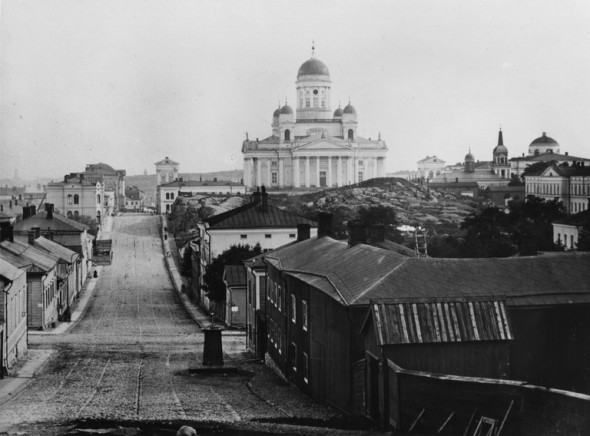
Strange and familiar: this picture, from 1865, shows the Cathedral, the Senate and the University Library surrounded by low wooden buildings and unbuilt land. Photo: Helsinki City Museum / CC BY-ND 4.0.

City of wood: beyond the familiar buildings of the few blocks of the then city centre, in this image from the 1860s, lie streets of modest one- and two-storey wooden houses. Photo: Gustaf Edvard Hultin , Helsinki City Museum / CC BY-ND 4.0.
Riitta Nikula: Suomalainen rivitalo. Työväen asunnosta keskiluokan unelmaksi. [The Finnish terraced house. From worker housing to middle-class dream.]
18 May 2015 | Mini reviews, Reviews
 Riitta Nikula
Riitta Nikula
Suomalainen rivitalo. Työväen asunnosta keskiluokan unelmaksi.
[The Finnish terraced house. From worker housing to middle-class dream.]
Helsinki: Suomalaisen Kirjallisuuden Seura (The Finnish Literature Society), 2014. 252 pp., ill.
ISBN 978-952-222-568-9
€ 37, hardback
In her extensive, well-researched book on the semi-detached house, Professor Emerita of Art History Riitta Nikula describes the housing history of a typical well-to-do Finn as setting off from a flat in an apartment building, continuing to a terraced house and ending up in a house of his or her own. In Finland rivitalo (simply, ‘row house’) became increasingly popular in the 1960s and the majority of houses of this type were built during the two decades that followed. However, in her book Nikula concentrates on the years 1900–1960, the decades of rapid industrialisation and urbanisation. In the 1930s Finland was eager to follow the renewal of town planning and architecture that was taking place elsewhere in Europe, and the rivitalo houses were part of the project of modernism. After the war the government funding system helped people to become owners of the properties they lived in, and the rivitalo became popular in growing towns. Prominent architects such as Eliel Saarinen, Alvar Aalto, Hilding Ekelund, Viljo Revell, and Kaija and Heikki Siren have all contributed to the development of this form of architecture. Nikula has travelled widely, in Europe and in Finland, researching this mode of living (the index of literature referred to alone fills seven large pages). The plentiful photographs and illustrations complement the text well.
Images of war
5 May 2015 | This 'n' that
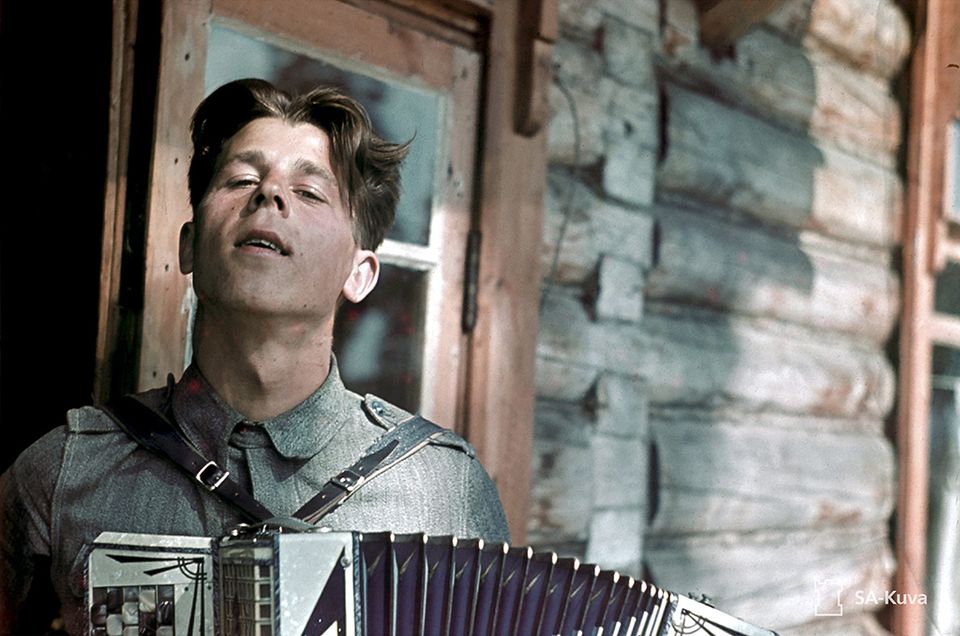
A soldier playing his accordion. Photo: SA-kuva
Between 1939 and 1944 Finland fought not one, but three separate wars – the Winter War (1939-45), the Continuation War (1941-44) and the Lapland War (1944-45).
We have become used to black-and-white images of the conflict, with their distancing effect. Among the 160,000 images in the Finnish Wartime Photograph Archive, however, are some 800 rare colour photographs from the Continuation War, which bring the realities of fighting much closer. The events pictured leap out of history and into the present. More…
Iconic Inha
5 February 2015 | This 'n' that
From time to time we have featured the charismatic photographs taken of Helsinki by I.K. Inha (1865-1050) in 1908 – most recently in a book pairing Inha’s iconic images with contemporary photographs of the same scenes by Martti Jämsä (2009). Fifty-one of the images have now been made available online to the public for the first time on the Finnish Museum of Photography’s Flickr page.
Many of the scenes are so little changed that it’s a shock to see them peopled with behatted gentlemen and ladies in long skirts. Commissioned for Finland’s first travel guide, the photographs show the handsome buildings, parks and seafronts of a solidly bourgeois looking city that is still the capital of a Russian province, an autonomous Grand Duchy actively fostering the dream of independence that is to be realised nine years later, in 1917.

Student Union Building on Itäinen Heikinkatu (now Mannerheimintie). I.K. Inha, 1908.
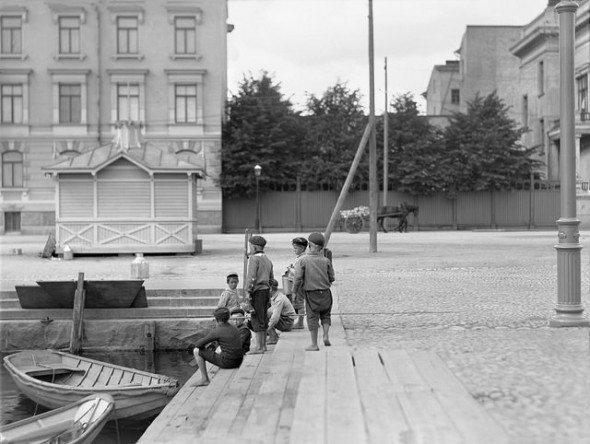
Boys at Hietalahti harbour. I.K. Inha, 1908.
Marjo Vilkko: Suomi on ruotsalainen [Finland is Swedish]
16 January 2015 | Mini reviews, Reviews
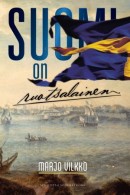 Suomi on ruotsalainen
Suomi on ruotsalainen
[Finland is Swedish]
Helsinki: Schildts & Söderströms, 2014. 321 pp.
ISBN 978-951-52-3419-3
€36, hardback
Finland was a part of the Swedish kingdom from the deep Middle Ages until 1809, when for a hundred years it was incorporated into Russia. The Swedish period left profound traces in Finnish society, and these were examined – with lively discussion – in the television series Finland is Swedish. Now the series scriptwriter and editor Marjo Vilkko has provided a more thoroughgoing treatment of the topic in her book. Although Finland is a country that shares Western and Nordic values, it differs from Sweden in several respects. For historical reasons and due to the presence of a significant Swedish-speaking minority, Swedish is still an official language; many things have moved from Europe to Finland via Sweden. However, at times the differences in Finland’s development have been emphasised by those wishing to propagate ‘original Finnish’ characteristics. With the use of fascinating examples and reflections drawn from history, Vilkko shows, for example, how Finland’s local government, legal system and Lutheran religion are to a large extent an inheritance from the Swedish period, with a continuous mutual interaction. The book moderately propagates the recognition of a common heritage and support for mutual understanding.
Translated by David McDuff
Herman Lindqvist: Kun Suomi oli Ruotsi [When Finland was Sweden]
18 December 2014 | Mini reviews, Reviews
 Kun Suomi oli Ruotsi
Kun Suomi oli Ruotsi
[When Finland was Sweden]
(original Swedish title: När Finland var Sverige, 2013)
Suom. [Translated from Swedish by] Heikki Eskelinen
Helsinki: WSOY, 2014. 497 pp., ill.
ISBN 978-951-0-40491-1
€44, hardback
The Swedish historian and journalist Herman Lindqvist is the author of dozens of popular non-fiction books. When Finland was Sweden is primarily intended for Swedish readers – an overview of the period when Finland was part of the Swedish kingdom – and it is partly based on new research. Finland became an integral part of the western neighbouring country in stages – including armed force – a process that was complete by the beginning of the fourteenth century. It remained an eastern borderland of the Kingdom of Sweden until the year 1809. The period was marked both by the rise of Sweden in the 16th century to become a great Baltic power and its decline in that role a hundred years later. Lindqvist connects up the different stages of Finland’s absorption into Sweden in a colourful and lively way. He shows how the influences went in both directions between the western and eastern part of the kingdom; the influence of the Finns could be seen both on the battlefields and in politics. The traces of the long time the two countries spent together are still visible today in both, thought in Finland they are stronger than in Sweden.
Translated by David McDuff
Mirkka Lappalainen: Pohjolan Leijona. Kustaa II Aadolf ja Suomi 1611–1632 [Lion of the North. Gustavus Adolphus and Finland, 1611–1632]
3 December 2014 | Mini reviews, Reviews
 Pohjolan Leijona. Kustaa II Aadolf ja Suomi 1611–1632
Pohjolan Leijona. Kustaa II Aadolf ja Suomi 1611–1632
[Lion of the North. Gustavus Adolphus and Finland, 1611–1632]
Helsinki: Siltala, 2014. 321 pp., ill.
ISBN 978-952-234-242-3
€31.50, hardback
The book presents a diverse and vivid history of the reign of Gustavus Adolphus – possibly the most important ruler in Swedish history – his era and his impact on Finland. When he rose to the throne at the age of just 17 in 1611, Finland was a strategically important region because of the threat posed by Russia and Poland. Among other things the king organised a meeting of representatives of the estates in Finland, the Regional Parliament of 1616 – even though he felt distrust of the Finnish people, who had supported the Polish King Sigismund, who had sought the Swedish crown. When the threat from the East had been repelled, Finland remained as a marginal corner of the world, which mainly provided taxes and soldiers. In 1630 the King, as a Lutheran soldier of faith, took his troops to Germany to fight in the Thirty Years War, and fell in 1632. However, in the period described the Swedish state, with Finland as a part of it, became a centralised state led by the King and his Chancellor Axel Oxenstierna, a system of government that was one of the most efficient in Europe. Lappalainen received the Finlandia Prize for Non-Fiction 2014 for her book.
Translated by David McDuff
Juho Kotakallio: Hänen majesteettinsa agentit. Brittitiedustelu Suomessa 1918–1941 [His Majesty’s agents. British Intelligence in Finland 1918–1941]
14 August 2014 | Mini reviews, Reviews
 Hänen majesteettinsa agentit. Brittitiedustelu Suomessa 1918–1941
Hänen majesteettinsa agentit. Brittitiedustelu Suomessa 1918–1941
[His Majesty’s agents. British Intelligence in Finland 1918–1941]
Jyväskylä: Atena, 2014. 297 pp., ill.
ISBN 978-952-300-025-4
€34, hardback
Historian Juho Kotakallio’s book deals with the work of the British Intelligence Service (SIS) in Finland from the Declaration of Independence (1917) to the early phase of the Continuation War (1941–1944). The Bolshevik Soviet state was also seen as a threat to Europe in its western neighbour Finland, which offered a key observation post for the gathering of secret intelligence about the Soviet Union. Undercover British agents took up residence in the country, and were moved to and fro across the eastern border. Russian émigrés and some Finns also worked for the British. One victim of the spy world was Sidney Reilly (considered to be a prototype of James Bond), who was lured through Finland to the Soviet Union, where he met his death by execution. In the 1930s the agents’ interest also increasingly focused on economics and on the growing power of Germany. During Finland’s Winter War with the Soviet Union in 1939–40 British intelligence was based more on openness and trust. After the outbreak of the so-called Continuation War, in December 1941, Britain declared war on Finland, and the possibilities for intelligence gathering there became fewer. The book, which gives a fascinating and objective view of the intelligence world, unfortunately lacks an index of names.
Translated by David McDuff
Petri Pietiläinen: Koirien maailmanhistoria [A world history of dogs]
24 April 2014 | Mini reviews, Reviews
 Koirien maailmanhistoria
Koirien maailmanhistoria
[A world history of dogs]
Helsinki: Finnish Literature Society, 2013. 344 pp .
ISBN 978-952-222-351-7
€34, hardback
By partly fictional means this book tells the compelling story of the dog, particularly from a cultural and historical perspective. Recent archaeological finds suggest that man has tamed dogs for more than 30,000 years. Descended from wolves, during the Stone Age they became common as domestic animals. In Finland, too, there have been finds that indicate that this was so. The dog was used for hunting and as a sentinel, and later in a variety of service tasks. From early on they were mythical creatures, worshipped in some cultures, in others shunned, and in some bred to be eaten. While in 17th-century Europe dogs were sentenced to death at trials, in Japan it was nobles who faced the death penalty for ill-treating their dogs. The book also presents the fascinating stories of dogs both famous and nameless, beginning with Alexander the Great’s dog Peritas. In the Western world the dog was not treated as a member of the family until the modern era, though in prehistoric burial sites there are indications of its having been a close companion of man. Pietiläinen links the story of the dog to more general history in an insightful way.
Translated by David McDuff
Antti Kujala: Neukkujen taskussa? Kekkonen, suomalaiset puolueet ja Neuvostoliitto 1956–71 [In the Soviets’ pocket? Kekkonen, the Finnish political parties and the Soviet Union 1956–71]
17 April 2014 | Mini reviews, Reviews
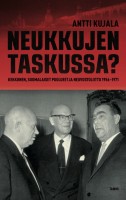 Neukkujen taskussa? Kekkonen, suomalaiset puolueet ja Neuvostoliitto 1956–71
Neukkujen taskussa? Kekkonen, suomalaiset puolueet ja Neuvostoliitto 1956–71
[In the Soviets’ pocket? Kekkonen, the Finnish political parties and the Soviet Union 1956–71]
Helsinki: Tammi, 2013. 392 pp., ill .
ISBN 978-951-31-7347-0
€39, hardback
In this book, which partly cites new sources in Russia, associate history professor Antti Kujala describes the nature of the policy pursued by President Urho Kekkonen during his term of office from 1956 to 19971 (he resigned in 1981). The parties were divided among themselves, and also to some extent internally. In political plotting secret support was sought after from both the Soviet Union and the West. Kekkonen was able to achieve a strong position, which he made use of. He sought to safeguard Finland’s interests with regard to the Soviet Union and created a good relationship with its leaders. At home, however, he used his position as a weapon against his opponents and tried to restrain criticism that could easily be interpreted as anti-Soviet. The Soviet Union viewed Finland as lying within its sphere of power and was able to influence many Finnish politicians and union leaders, as well as the composition of the government. The section of the book in question contains an account of the central phenomena of Finland’s political history: the influence of the Soviet Union, as manifested by the ‘night frosts’ and the so-called ‘Note Crisis’, and Finland’s reactions to the occupation of Czechoslovakia by Soviet troops in 1968.
Translated by David McDuff
Timo Vihavainen: Ryssäviha. Venäjän-pelon historia [Ryssäviha. A history of Russophobia in Finland]
10 April 2014 | Mini reviews, Reviews
 Ryssäviha. Venäjän-pelon historia
Ryssäviha. Venäjän-pelon historia
[Ryssäviha. A history of Russophobia in Finland]
Helsinki: Minerva Kustannus Oy, 2013. 322 pp.
ISBN 978-952-492-778-9
€31.90, hardback
In this well-written polemical study Professor Timo Vihavainen examines Russophobia mainly from a Finnish point of view, but also in a European context. He also writes about the reverse phenomenon, the emergence in Russia of xenophobia and accusations of ‘Russophobia’ among neighbouring countries. In 20th-century Europe it was more a question of opposition to the Soviet Union and its ideological system than of Russophobia as such. During the late 19th century Finland, which had been part of Russia from 1809 to 1917, saw the rise of so-called ryssäviha, ‘Russia-hate’, which began in the period of Russification and increased during the Civil War of 1917–1918. Between the World Wars it persisted especially in Akateeminen Karjala-Seura (‘The Academic Karelia Society’), a right-wing student organisation, and was fuelled by reports of political terror from across the eastern border, though even then a significant part of Finland’s working class saw the Soviet Union in a favourable light. During the Second World War ryssäviha came to a head in response to a conflict perceived as unjust, and to territorial concessions. In the 1960s, partly for political reasons, anti-Soviet sentiment became replaced by pro-Soviet attitude. Since the break-up of the Soviet Union in the 1990s relations with Russia have largely been free of problems.
Translated by David McDuff
Tarmo Kunnas: Fasismin lumous. Eurooppalainen älymystö Mussolinin ja Hitlerin politiikan tukijana [The allure of fascism. European intellectuals as backers of the policies of Mussolini and Hitler]
13 March 2014 | Mini reviews, Reviews
 Fasismin lumous. Eurooppalainen älymystö Mussolinin ja Hitlerin politiikan tukijana
Fasismin lumous. Eurooppalainen älymystö Mussolinin ja Hitlerin politiikan tukijana
[The allure of fascism. European intellectuals as backers of the policies of Mussolini and Hitler]
Jyväskylä: Atena , 2013. 686 pp .
ISBN 978-951-796-933-8
€40, hardback
The most prominent fascist states in the period between the world wars were Nazi Germany and Mussolini’s Italy, but the ideology was reflected in the extremist movements of a number of European countries. The fascist movements could differ greatly, but their key feature was a strong nationalism that was both anti-democratic and anti-parliamentary. In his book, which at times is rather heavy going, Emeritus Professor Tarmo Kunnas examines the attraction of Fascist ideology for the European intelligentsia of the 1920s, 30s and 40s. He presents a nuanced view of the opinions of the period’s major intellectuals and detects the sources of their world outlook in factors like their philosophy of life. Their fascism rarely fitted in with party political programmes. Kunnas also sheds light on the fascist views of some of Finland’s cultural figures; according to him, in Finland genuine fascist groups did not really have much significance.
